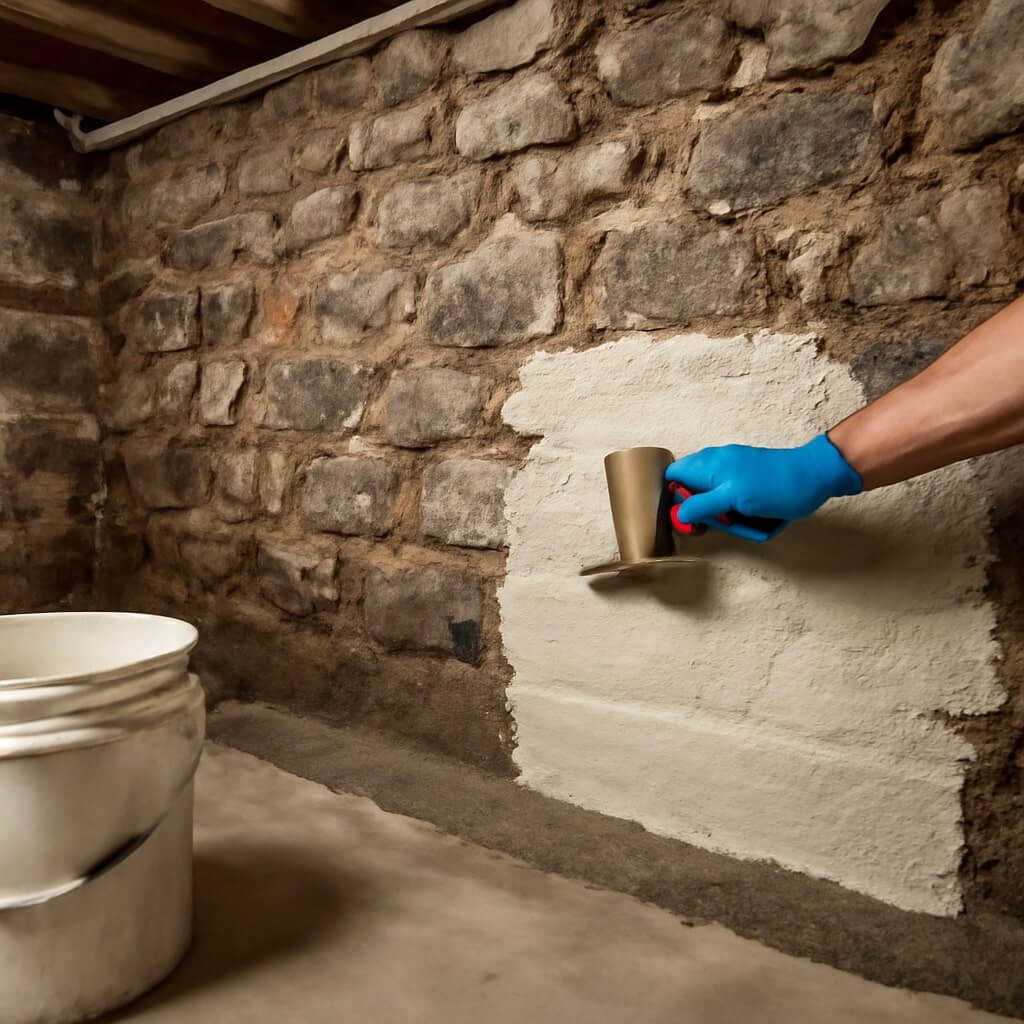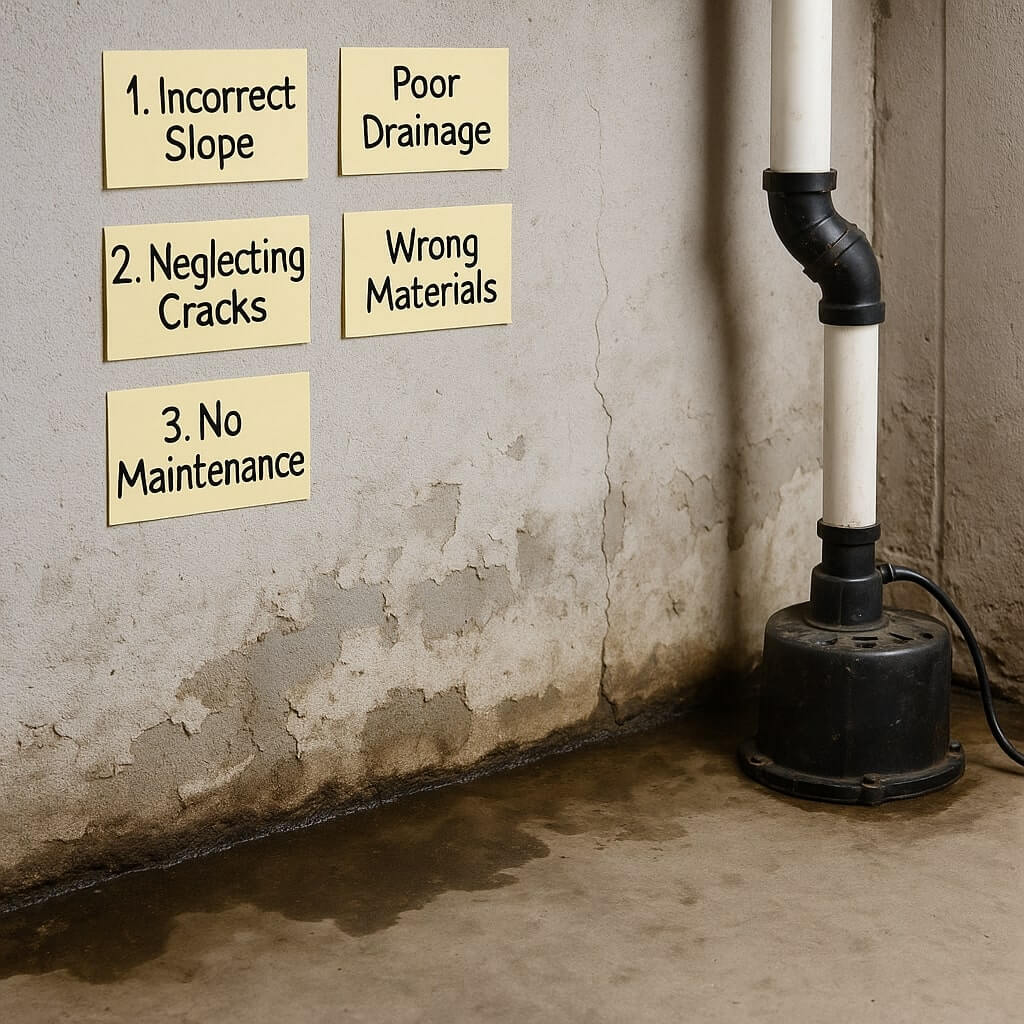If you own an old stone basement, you know how moisture can create serious problems. It’s essential to understand the causes of this moisture and assess the condition of your walls. Cleaning the surface and applying the right waterproofing sealants can make a significant difference. But there’s more to it, like installing drainage systems and improving ventilation. Let’s explore these effective methods to keep your basement dry and maintain its integrity.
Key Takeaways
- Conduct a thorough assessment of stone walls to identify cracks and moisture issues before waterproofing.
- Clean surfaces with pressure washing and specialized cleaners to ensure proper adhesion of sealants.
- Apply high-quality waterproofing sealants, ensuring all gaps and joints are thoroughly covered.
- Install interior drainage systems, such as French drains and sump pumps, to manage water accumulation effectively.
- Maintain humidity levels and ventilation to prevent moisture buildup and protect against mold growth.
Understanding the Causes of Moisture in Stone Basements
Moisture in stone basements can stem from several sources, making it crucial to understand these causes to effectively tackle the problem.
Common moisture sources include groundwater seepage, poor drainage systems, and high humidity levels. Rainwater may infiltrate through cracks or porous stone, while condensation can occur due to inadequate humidity management.
Inspecting gutters and downspouts guarantees that water is directed away from your foundation. Additionally, maintaining a dehumidifier can greatly reduce indoor humidity, helping to prevent mold and structural damage.
Assessing the Condition of Your Stone Walls
To effectively assess the condition of your stone walls, start with a thorough visual inspection to identify any cracks, discoloration, or signs of moisture.
Next, utilize moisture detection tools to pinpoint damp areas that may not be visible to the naked eye.
Finally, evaluate the structural integrity by checking for loose stones or any shifts in the wall’s alignment, ensuring your assessment is exhaustive and accurate.
Visual Inspection Techniques
While you might be enthusiastic to start waterproofing your old stone basement walls, a thorough visual inspection is essential for understanding their condition first.
Look for visual cues like cracks, discoloration, or efflorescence, which can indicate moisture problems. Pay attention to structural indicators such as loose stones or crumbling mortar, as these can compromise the wall’s integrity.
Use a flashlight to illuminate dark corners and examine joints, ensuring there’s no hidden damage. Document your findings, noting any areas that require immediate attention.
This careful assessment will help you prioritize repairs and effectively plan your waterproofing strategy.
Moisture Detection Tools
How can you accurately assess the moisture levels in your old stone basement walls?
Start by using moisture meters, which can provide precise readings of the moisture content in your stone. These tools help you identify areas that are prone to dampness.
Additionally, consider implementing leak detection techniques, such as infrared cameras or acoustic leak detectors, to spot hidden leaks and moisture sources.
Regularly checking these levels guarantees you catch potential issues early, preventing further damage.
Structural Integrity Assessment
After you’ve assessed moisture levels, it’s important to evaluate the structural integrity of your stone basement walls.
Begin by inspecting for cracks, crumbling, or shifting stones, as these issues can compromise foundation stability. Use a level to check for uneven surfaces, which may indicate settling or movement.
Pay attention to the mortar; deteriorated joints can decrease moisture resistance and lead to further damage. If you spot significant problems, consulting a professional is wise.
Regular assessments guarantee your walls remain structurally sound, safeguarding your home from water infiltration and preserving the overall integrity of your foundation.
Cleaning and Preparing the Surface
To effectively waterproof your old stone basement walls, start by thoroughly cleaning and preparing the surface.
Proper surface preparation guarantees better adhesion of waterproofing products. Here are three effective cleaning methods:
Proper surface preparation is key for ensuring waterproofing products adhere effectively to your stone basement walls.
- Pressure Washing: Use a pressure washer to remove dirt, mold, and loose debris from the stone.
- Scrubbing: For stubborn stains, scrub the walls with a stiff brush and a mixture of water and mild detergent.
- Chemical Cleaners: Apply a specialized cleaner designed for stone surfaces to eliminate mildew and efflorescence.
After cleaning, let the surface dry completely before moving on to the next steps in waterproofing.
Applying Waterproofing Sealants
Once your stone basement walls are clean and dry, it’s time to apply waterproofing sealants for maximum protection against moisture.
Begin your sealant application by ensuring thorough surface preparation; this includes filling any cracks and gaps with appropriate materials.
Choose a high-quality sealant designed for stone surfaces and mix it as recommended.
Using a roller or brush, apply the sealant evenly, working from the bottom up to prevent drips.
Make sure to cover all areas, including joints and seams.
Allow the sealant to cure fully before subjecting the walls to moisture, ensuring long-lasting protection for your basement.
Installing Interior Drainage Systems
When it comes to waterproofing your old stone basement, installing an interior drainage system can be a game-changer.
You’ll find various types of drainage systems available, each designed to handle water differently. Understanding the installation process is essential to guarantee effective moisture control and protect your home from water damage.
Types of Drainage Systems
While addressing moisture issues in old stone basements, installing an interior drainage system is essential for effective waterproofing.
Understanding different drainage types can help you choose the best solution. Here are three common drainage systems:
- French Drains: These involve perforated pipes to redirect water away from walls, offering excellent drainage benefits.
- Interior Drainage Channels: These are installed along the perimeter of the basement floor, capturing water before it reaches your walls.
- Sump Pumps: These pumps remove accumulated water, preventing flooding and further moisture issues.
Selecting the right system can greatly enhance your basement’s protection against water damage.
Installation Process Overview
Before you begin the installation of an interior drainage system in your old stone basement, it’s essential to gather the right tools and materials. Start with waterproofing products like drainage tiles and sump pumps.
Using proper installation techniques, first, remove any debris from the basement floor. Next, dig a trench along the perimeter, ensuring it slopes toward the sump pit.
Install the drainage tiles, covering them with gravel for better water flow. Finally, connect the sump pump to remove collected water efficiently.
This method effectively prevents moisture buildup, protecting your basement from potential water damage.
Utilizing Exterior Waterproofing Techniques
To effectively protect your old stone basement walls, utilizing exterior waterproofing techniques is essential.
Utilizing exterior waterproofing techniques is vital for safeguarding your old stone basement walls from moisture damage.
Start by guaranteeing proper exterior drainage; this helps divert water away from your foundation.
Next, focus on soil grading; the ground should slope away from the house to prevent water accumulation.
Finally, consider applying a waterproof sealant to the exterior walls, creating an additional barrier against moisture.
Here’s a quick checklist:
- Guarantee proper exterior drainage systems are in place.
- Grade the soil to slope away from your home.
- Apply a waterproof sealant to the stone walls.
These steps will help keep your basement dry.
Improving Gutters and Downspouts
Improving gutters and downspouts is essential for preventing water from pooling around your old stone basement walls. Regular gutter maintenance guarantees that debris doesn’t clog your system, allowing water to flow freely away from your foundation. Check your downspout alignment; they should direct water at least three feet from your home.
| Task | Frequency | Importance |
|---|---|---|
| Clean gutters | Twice a year | Prevents clogs |
| Inspect downspouts | Annually | Guarantees proper flow |
| Adjust downspout angle | As needed | Redirects water properly |
| Repair leaks | Immediately | Prevents damage |
| Check for sagging | Biannually | Maintains effectiveness |
Enhancing Ventilation in the Basement
While water management is essential, enhancing ventilation in your basement is equally important for maintaining a dry and healthy environment.
Improving airflow helps prevent mold and mildew. Here are three effective ways to boost ventilation:
- Install Ventilation Systems: Consider options like exhaust fans or air exchange systems to promote air circulation.
- Create Natural Airflow: Open windows or vents whenever possible to allow fresh air in and stale air out.
- Use Dehumidifiers: These machines can help remove excess moisture, further enhancing air quality.
Implementing these methods will greatly improve your basement’s ventilation and overall atmosphere.
Monitoring Humidity Levels
To effectively manage moisture in your old stone basement, you need to monitor humidity levels regularly.
Use tools like hygrometers to measure the humidity, ensuring it stays between 30% and 50% for ideal conditions.
Keeping your humidity in check helps prevent mold growth and protects your walls from damage.
Humidity Measurement Tools
How can you guarantee your basement remains dry and mold-free? One effective way is to use humidity measurement tools that help with humidity control.
Here are three essential tools to take into account:
- Digital Hygrometers: These devices measure and display current humidity levels in real time, providing immediate feedback.
- Moisture Sensors: Placing moisture sensors in key areas helps detect dampness early and alerts you to potential issues.
- Data Loggers: These record humidity levels over time, allowing you to track changes and trends for better management.
Using these tools guarantees you stay ahead of moisture problems in your basement.
Ideal Humidity Levels
Maintaining ideal humidity levels in your basement is essential for preventing mold growth and structural damage. Aim for a relative humidity of 30-50%.
To monitor this, invest in a hygrometer to track moisture levels effectively. If you find humidity levels exceeding the ideal range, consider implementing humidity control methods like dehumidifiers or ventilation systems.
Regularly check and adjust settings based on seasonal changes, as external conditions can considerably affect your basement’s moisture levels.
Regular Maintenance and Inspections
While it might seem tempting to ignore the basement after waterproofing, regular maintenance and inspections are essential for guaranteeing the longevity of your stone walls.
Implementing routine checks will help you catch issues early and take preventive measures. Here are three key tasks to prioritize:
- Inspect for Cracks: Regularly examine walls for new cracks or water stains.
- Check Drainage Systems: Confirm gutters and downspouts direct water away from the foundation.
- Monitor Humidity: Keep an eye on humidity levels to prevent mold growth.
Conclusion
By following these effective methods for waterproofing your old stone basement walls, you can greatly reduce moisture issues and protect your home from damage. Start with a thorough assessment and cleaning, then apply high-quality sealants and install drainage systems as needed. Don’t forget to improve your gutters and enhance ventilation to keep humidity in check. Regular maintenance and inspections will guarantee your efforts remain effective, giving you peace of mind and a dry, safe basement for years to come.




